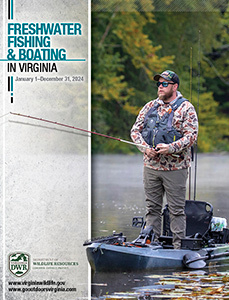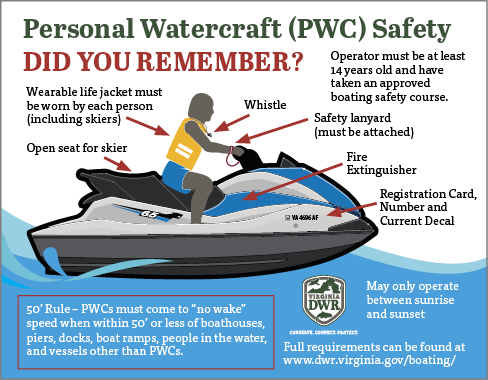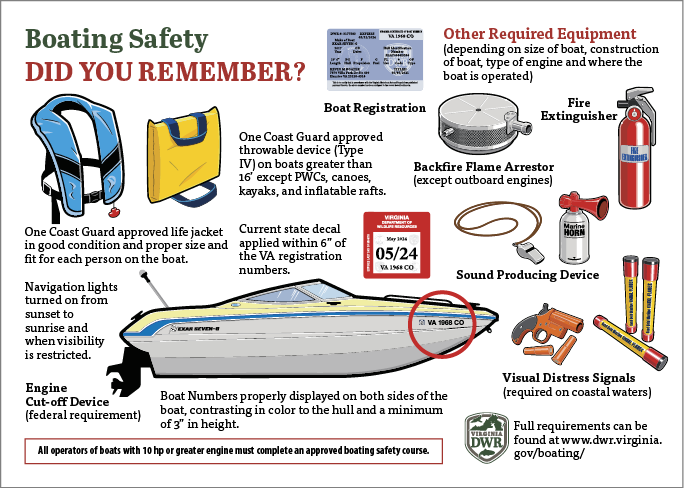Safe Boating
Safe Boating
Virginia Boating Safety Education
All PWC operators and motorboat operators of boats registered in Virginia with a motor of 10 horsepower and greater must take a boating safety course.
Boating Education Courses
The DWR provides a free classroom boating safety course, Boat Virginia. This course is available throughout the year. The DWR also supports NASBLA approved boating courses offered by the USCG Auxiliary (USCGAux) and the U.S. Power Squadrons (USPS). There are several internet courses that meet Virginia’s Boating Safety Education Requirement.
- For a up-to-date list of boating safety education course offerings and boating safety information, visit our website at www.virginiawildlife.gov/boating/education/requirement/.
To arrange a free vessel safety check, please call 1-800-245-2628, go to http://cgaux.org/vsc/, or contact local USCG Auxiliary or USPS member.
Do I Need to Take a Boating Course?
YES: If you have never taken a NASBLA approved boating safety course and you operate a PWC or a boat registered in Virginia with a motor of 10 horsepower and greater.
NO: If you have previously taken a NASBLA approved boating safety course and still have a card/certificate.
NO: If you are serving or have qualified as an Officer of the Deck Underway, boat coxswain, boat officer, boat operator, watercraft operator, or Marine Deck Officer in any branch of the Armed Forces of the United States, United States Coast Guard, or Merchant Marine.
NO: If you hold or have held a license to operate a vessel (Master, Captain, or Mate).
NO: If you are or have been a Registered Commercial Fisherman with the Virginia Marine Resources Commission (VMRC).
NO: If you are or have been a surface warfare officer/enlisted surface warfare specialist in the United States Navy.
General Information
- You must carry proof of course completion on board with you while operating.
- If your boat is registered in another state you must meet your home state’s education requirement.
- If you are planning to rent a boat, please check with the boat rental company.
- Refer to our website for more details about the education requirement.
Enforcement
Boating laws are enforced primarily by Conservation Police Officers employed by DWR. These officers have full police powers and have the right to lawfully stop and board your boat at any time to check for proper registration and required safety equipment.
The Law about Alcohol, Drugs, and Boating
Virginia’s law states that boat operators with blood alcohol concentrations of .08 percent or more by weight, by volume, shall be presumed to be under the influence of alcoholic intoxicants. Operating a boat under the influence is a Class I Misdemeanor and can result in up to a $2,500 fine and/or up to 12 months in jail as well as the loss of the privilege to operate a motorboat for up to a year.
Implied Consent
The Virginia Implied Consent Law states that by operating a watercraft, you are agreeing to submit to a breath and/or blood test to determine the amount of alcohol and/or drugs in your blood. Unreasonable refusal to submit to these tests constitutes grounds for the revocation of the operator’s privilege to operate a watercraft on the waters of the Commonwealth.
Zero Tolerance Law
Virginia Law prohibits persons younger than 21 from consuming alcohol and operating a watercraft with any measurable alcohol level. Operation under the influence of alcohol or other drugs is a criminal offense. Additionally, persons age 18–20 arrested buying, possessing, or drinking alcohol can be fined up to $2,500, lose their motor vehicle operator’s license for up to 1 year, and be sent to jail.
Protect Yourself
Don’t allow a drinking boater to make you and your passengers boating fatality statistics. Be alert to what other boaters are doing and steer clear of boaters who may be abusing alcohol and/or drugs.
Speed Laws
No Wake
- “No Wake” is defined as the slowest possible speed required to maintain steerage and headway.
- It shall be unlawful to operate any motorboat greater than no wake speed in areas marked with regulatory “No Wake” buoys.
- It shall be unlawful to operate any motorboat greater than no wake speed when within 50 feet or less of docks, piers, boathouses, boat ramps, and people in the water. This definition does not prohibit the pulling of a skier with a rope of less than 50 feet, nor a person accompanying the motorboat (wake surfing) provided the motorboat is propelled by an inboard motor.
Slacken Speed
Operators shall reduce speed to avoid endangering persons or property by the effect of the motorboat’s wake when approaching or passing vessels under way, lying to, at anchor, or made fast to the shore; or, when approaching or passing piers, docks, or boathouses; or when approaching or passing persons in the water or using water skis or surfboards.
Safe Speed
A safe speed is a speed less than the maximum at which the operator can take proper and effective action to avoid collision and stop within a distance appropriate to the prevailing circumstances and conditions.
In establishing a safe operating speed, the operator shall take into account: visibility, traffic density, ability to maneuver the vessel (stopping distance and turning ability), background light at night, proximity of navigational hazards, draft of the vessel, limitations of radar equipment, and the state of wind, sea, and current.
New Move Over Law
Every motorboat, when approaching or passing within 200 feet of any law enforcement vessel or emergency services vessel that is displaying flashing blue or red lights, shall slow to no-wake speed so that the effect of the wake does not disturb the activities of the law enforcement or emergency services personnel. Where the operator of a motorboat fails to comply with this regulation, and where such failure endangers the life or limb of any person involved or endangers or damages the vessels involved, the operator shall be guilty of a Class 3 misdemeanor and, upon conviction, shall be additionally required to complete and pass a NASBLA-approved safe boating course.
Other Unlawful Acts
- No person shall operate any motorboat or vessel, or manipulate any skis, surfboard, or similar device in a reckless manner so as to endanger the life, limb, or property of any person.
- It is unlawful to allow any person to ride or sit on the bow, gunwale, transom, or on the decking over the bow of the vessel while under power unless such motorboat is provided with adequate guards or railing to prevent passengers from falls overboard. Passengers or other persons aboard a watercraft may occupy these areas of the vessel to moor or anchor the watercraft, to cast off, or for any other necessary purpose.
- No person shall operate or allow another person to operate an unregistered motorboat, a boat with an expired certificate of number, a boat with the number improperly displayed, an unauthorized number displayed, or without carrying the certificate of number onboard.
- No person shall operate a boat without exhibiting the lights as required by law between sunset and sunrise.
- No person shall fail to stop, render assistance, give their name and address at the scene of an accident, or report an incident in the proper timeframe (see Aids to Navigation).
- No person shall operate a boat in a manner that violates any regulatory marker.
- No person shall operate a boat, skis, or similar device in an area designated for swimming.
- No person shall engage in snorkeling or scuba diving in waters open to boating without displaying a diver-down flag. All vessels must stay at least 25 yards away when the flag is displayed.
Towed Watersports Safety
The boating law contains several provisions related to the towing of persons on water skis, tubes, surfboards, or similar devices and the manipulation of such devices by the person being towed.
- All boats towing a water skier(s) or other persons on towed devices MUST have ONE of the following:
- Persons being towed must be wearing a USCG approved life jacket or
- There must be an observer on the boat (in addition to the operator) who is in a position to observe the progress of the skier.
- A person(s) being towed on water skis or other device may not operate in a reckless or dangerous manner.
- A person(s) being towed on water skis or other device may not operate while under the influence of alcohol or drugs, including prescription narcotics and illegal drugs.
- The operator of the boat towing a water skier(s) or person(s) on another towing device may not manipulate or control the boat so as to cause the person(s) being towed to collide with any object or person.
- Water skiing behind a motorboat (or towing of people on other devices) is allowed only between one-half hour before sunrise to one-half hour after sunset. Check the official sunrise and sunset times for your area.
- Water skiing behind a PWC (or towing of people on other devices) is allowed only between sunrise to sunset. Check the official sunrise and sunset times for your area.
Personal Watercraft (PWC) Operation
A personal watercraft is a motorboat less than 16 feet in length which uses an inboard motor powering a jet pump as its primary motive power and which is designed to be operated by a person sitting, standing or kneeling on, rather than in the conventional manner of sitting or standing inside the vessel.
PWCs must follow all rules and regulations for motorboats. There are additional rules and regulations for PWC operators as follows:
- It shall be unlawful for any person to operate a PWC, or the owner or any person having control to authorize or knowingly permit a person to operate a PWC, unless the operator is at least 16 years of age. Any person age 14 or 15 may operate a PWC if they have successfully completed an approved boating education safety course, carry proof of successful completion of such course, and show this proof upon request by a law enforcement officer.
- It is unlawful to operate a PWC unless the operator, each rider and anyone being towed by a PWC is wearing a USCG approved wearable life jacket suited for this activity. Inflatable life jackets are prohibited.
- If the PWC is equipped with a lanyard-type engine cut-off switch, the operator must attach the lanyard to his person, clothing, or life jacket.
- It is unlawful to operate a PWC after sunset or before sunrise.
- It is unlawful to operate a PWC while carrying passengers in excess of the number for which the craft was designed by the manufacturer; including towed passengers.
- A person shall be guilty of reckless operation who operates any PWC recklessly so as to endanger the life, limb, or property of any person, which shall include, but not be limited to: (1) weaving through other vessels which are underway, stopped, moored or anchored while exceeding a reasonable speed; (2) following another vessel or skier, crossing the path of another vessel or skier, crossing the path of another vessel more closely than is reasonable and prudent; (3) crossing between the towing vessel and a skier; or (4) steering toward an object or person and turning sharply in close proximity to such object or person in order to spray or attempt to spray an object or person with the wash or jet spray of the PWC.
- PWC operators must maintain “no wake” operation when within 50 feet or less of docks, piers, boathouses, boat ramps, people in the water and vessels other than PWCs. PWCs may tow a skier with a rope less than 50 feet. No wake is defined as “The slowest possible speed required to maintain steerage and headway.”
The above provisions do not apply to participants in regattas, races, marine parades, tournaments or exhibitions approved by the Board of the DWR or the USCG.
Navigation Rules
Most boating accidents are the result of a collision, either between two vessels, or between a vessel and a fixed or submerged object. For this reason, boat operators are cautioned to follow the established Navigation Rules, especially maintaining a proper lookout and safe speed. Remember the three basic rules of navigation:
- Practice Good Seamanship — it is the responsibility of every vessel or PWC operator to take all necessary action to avoid collisions. Such action should be taken in ample time to avoid a collision and at a safe distance from other vessels.
- Keep a Proper Lookout — every operator must keep a proper lookout using both sight and hearing at all times. Watch and listen for other vessels, radio communications, navigation hazards, and others involved in water activities.
- Maintain a Safe Speed — safe speed will vary depending upon conditions such as wind, water conditions, navigation hazards, visibility, surrounding vessel traffic, and the maneuverability of your vessel.
The boat operator is responsible for knowing and following all of the applicable navigation rules. Copies of the rules may be obtained from the Superintendent of Documents, U.S. Government Printing Office, Washington, D.C. 20402, 202-512-1800. The stock number is 050-012-00192-8. On the Web at: http://uscgboating.org/regulations/navigation-rules.php.
Right Side = Starboard
Left Side = Port
Head-on (bow to bow)
When two power-driven vessels are meeting head-on or nearly head-on, each shall alter her course to starboard (right) so that each shall pass on the port side of the other. A head-on situation exists when a vessel sees the other ahead or nearly ahead and by night she could see the masthead lights of the other in a line or nearly in a line or both sidelights.
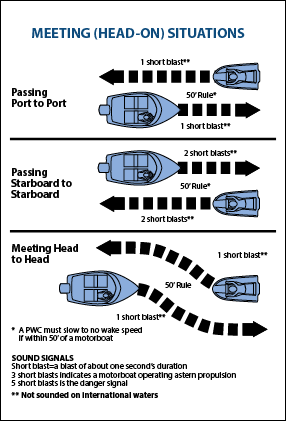
Giveway and Stand-on Vessels
Give-way and Stand-on is the terminology used to describe the appropriate action of each vessel in crossing and passing situations.
The “give-way” vessel is the vessel that must take early and substantial action to keep well clear of another vessel.
The “stand-on” vessel shall maintain course and speed unless it becomes apparent that the vessel required to keep out of the way (the “give-way” vessel) is not taking the appropriate action. If the stand-on vessel must take action to avoid a collision, it must avoid turning to port for a vessel on her port side.
An action taken to avoid a collision needs to be positive, made in ample time and large enough to be apparent to the other vessel. If necessary to avoid a collision or allow more time to assess the situation, a vessel must slacken her speed or take all way off by stopping or reversing engines.
In crossing situations, power boats must give-way to sailing vessels under sail regardless of the angle the power-driven vessel approaches the sailing vessel.
Crossing
When two power-driven vessels are crossing, the vessel which has the other on her starboard side shall give way and keep out of the way and avoid crossing ahead (in front) of the other vessel.
When taking action to stay out of the way, make it early, substantial and well clear of the other boat. Avoid making a succession of small alterations of course or speed. If you are directed by the Rules to stay out of the way, then make your turn large and obvious so as to be readily apparent to another vessel both visually or by radar. This is especially true at night, when the only visual indication of your course change is the alteration of your boat’s lights.
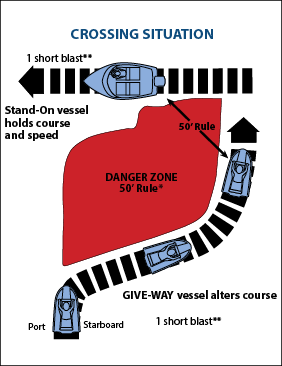
Overtaking
Any vessel overtaking any other shall give-way and keep out of the way of the vessel being overtaken.
When a vessel is in any doubt as to whether it is overtaking another, it shall assume that this is the case and act accordingly.
If you are being overtaken (passed), you are the stand-on vessel and should maintain your course and speed. The vessel overtaking you should notify an intent to pass by making an appropriate sound signal. One short blast of the horn or whistle means “I intend to overtake you on your starboard side” and 2-short blasts means “I intend to overtake you on your port side”.
When two sailing vessels are approaching one another in a crossing situation, one of them shall keep out of the way of the other as follows:
- When each has the wind on a different side, the vessel which has the wind on the port side shall keep out of the way of the other;
- When both have the wind on the same side, the vessel which is to windward shall keep out of the way of the vessel which is to leeward; and
- If a vessel with the wind on the port side sees a vessel to windward and cannot determine with certainty whether the other vessel has the wind on the port or on the starboard side, she shall keep out of the way of the other.
Windward side is deemed to be the side opposite to that on which the main-sail is carried.
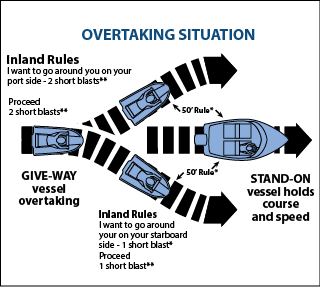
Responsibility Between Vessels
Except where otherwise required:
A power-driven vessel shall keep out of the way of:
- A vessel not under command
- A vessel restricted in her ability to maneuver, such as a tug boat or deep-draft freighter
- A vessel engaged in commercial fishing
- A sailing vessel
A sailing vessel shall keep out of the way of:
- A vessel not under command
- A vessel restricted in her ability to maneuver, such as a tug boat or deep-draft freighter
- A vessel engaged in commercial fishing
Departure From Regulations To Avoid Immediate Danger
At times it may be necessary to depart from these rules in order to avoid immediate danger. When, from any cause the vessel required to keep its course and speed finds itself so close that collision cannot be avoided by the action of the give-way vessel alone, the operator shall take such action as will best aid to avoid collision. This action does not relieve the give-way vessel of its obligation to keep out of the way. The give-way vessel is that vessel required to take early and substantial action to keep well away from other vessels by stopping, slowing or changing course.
Narrow Channels
In narrow channels, the operator of every vessel shall, when it is safe and practicable, keep to that side of the fairway or mid-channel which lies on the right side of such vessel. The operator of a vessel under 65.6 feet in length underway, fishing or at anchor in narrow channels shall not interfere with the passage of large, deep-draft vessels that can safely navigate only inside such channels.
Restricted Visibility
The following rule applies to vessels not in sight of one another when navigating in or near an area of restricted visibility:
Proceed at a safe speed adapted to the prevailing circumstances and conditions of restricted visibility. A power-driven vessel shall have engines ready for immediate maneuver.
Except where it has been determined that a risk of collisions does not exist, every vessel which hears apparently forward of her beam the fog signal of another vessel, or which cannot avoid a close-quarter situation with another vessel forward of her beam, shall reduce her speed to the minimum at which she can be kept on course. She shall if necessary take all way off (slow down or stop) and in any event, navigate with extreme caution until danger of collision is over.
Sound Signals for Restricted Visibility
Whistle means any sound producing device capable of producing a blast.
Short Blast = a blast of about 1 second.
Prolonged Blast = a blast of from 4–6 seconds’ duration.
In or near an area of restricted visibility, whether by day or night, the following sound signals shall be made:
- A power-driven vessel making way through the water — one prolonged blast at least once every 2 minutes.
- A power-driven vessel underway but stopped and making no way through the water shall sound at intervals of not more than 2 minutes two prolonged blasts in succession with an interval of about 2 seconds between them.
- A sailing vessel, whether underway or at anchor, shall sound one-prolonged blast followed by two-short blast at least once every 2 minutes.
Did you get your Virginia Lifetime Boater’s Card?
Our Virginia Lifetime Boater’s Card is available to those who meet the boating safety education requirement. This durable, drivers license-style card is available for a fee of $10.00.
- Completed a NASBLA approved boating safety course (U.S. Power Squadrons, U.S. Coast Guard Auxiliary, other states’ boating safety courses, or internet courses)
- Completed a Virginia Challenge Exam
- Have lost your original Boat Virginia card
- - Meet any of the exemptions listed under Boating Education Course
To purchase a card go to www.virginiawildlife.gov/boating/lifetime-boater-card/.
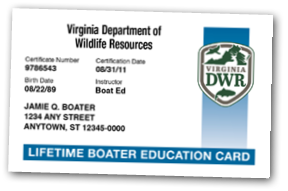
Motorboat and PWC Operators
A Boating Safety Course is Required to Operate PWC’s and/or Boats With Motors 10 HP or Greater.
For more information:
www.virginiawildlife.gov/boating/education/requirement/
Other Safety Concerns
Boating Accident Reporting
As the operator of a vessel, you are required by law to file a formal, written report of your boating accident with the DWR under certain circumstances.
To inform Law Enforcement about an accident that has just occurred, please call your county or city law enforcement group, sheriff’s office, Conservation Police Officer, or Department dispatcher (800-237-5712) or 911.
When a Report is Required
A formal, written report must be filed with DWR when there is:
- Damage over $2000 by or to the vessel or its equipment;
- Injury (requiring medical help beyond First Aid) or loss of life; and/or
- Disappearance of any person from a vessel.
When a person dies or disappears as a result of an occurrence that involves a vessel or its equipment, the operator is required by law to notify the DWR in Henrico, Virginia, or the most immediately available Department Conservation Police Officer without delay and by the quickest means possible.
Time Frame for Reporting
Written reports must be filed within the following time frames from the boating accident:
- 48 hours, if a person dies within 24 hours of the accident;
- 48 hours if a person involved is injured and cannot perform usual activities;
- 48 hours if a person disappears from a vessel;
- 10 days if an earlier report is not required but becomes necessary; and/or
- 10 days if the boat or property damage is in excess of $2000 or total boat loss.
How to File a Written Accident Report
Boating Accident Report forms can also be obtained from local law enforcement authorities, Department Conservation Police Officers, DWR website, and all Department offices. You may submit the completed forms in person or send them to the Virginia Department of Wildlife Resources, Boating Accident, 7870 Villa Park Dr., Suite 400, P.O. Box 90778, Henrico, VA 23228. The boat operator or owner usually completes the form unless she/he is physically unable to do so.
Duty to Stop and Render Assistance
It is the duty of every operator involved in a collision to stop and offer assistance. Operators involved in a collision, who knowingly fail to comply with this law when the collision or accident results in serious bodily injury to, or the death of, any person, shall be guilty of a Class 6 Felony. When a collision or accident results in only property damage, the operator who does not comply with this law shall be guilty of a Class 1 Misdemeanor.
Naval Protection Zones
All vessels must operate at minimum speed necessary to maintain a steerage and headway (no wake speed) within 500 yards of the U.S. naval vessel and proceed as directed by the Commanding Officer or the official patrol. Violations of the Naval Vessel Protection Zone are a felony offense, punishable by up to 6 years in prison and/or up to $250,000 in fines.
No vessel or person is allowed within 100 yards of a U.S. naval vessel greater than 100 feet in length. Due to Little Creek Channel’s width of 150 yards, all vessels must exit Little Creek Channel when a U.S. naval vessel is approaching.
If you have questions about the Navel Vessel Protection Zone, contact Coast Guard Sector Hampton Roads Waterways Management Division at 757-668-5580.

America’s Waterway Watch
America’s coasts, rivers, bridges, tunnels, ports, ships, military bases, and waterside industries may be the terrorists’ next targets.
If you see outwardly suspicious activity, or even behavior that makes you uneasy, please report it. Here are things to look for:
- Unattended vessels or vehicles in unusual locations.
- Unusual night operations.
- Recovering or tossing items into/onto the waterway or shoreline.
- Operating in or passing through an area that does not typically have such activity.
- Missing fencing or lighting near sensitive locations.
- Transfer of people or items between vessels, or between vessels and the shore outside of a port.
- Anyone operating in an aggressive manner.
- Small planes flying over critical locations.
- Persons attempting to buy or rent fishing or recreational vessels with cash for short-term, undefined use.
- Other suspicious activity.
Call the National Response Center at 877-24WATCH (249-2824) or 911 to report suspicious activity.
Boat Theft Prevention
When Buying a Boat
- Be careful because it could be stolen.
- Be certain that the boat’s description on the title matches the boat you are buying. Check year, make, length, and hull identification number.
- Be sure the model and serial number on an outboard motor have not been removed, tampered with or altered.
- Be suspicious of a fresh paint job on a late model vessel.
- When buying a used vessel, try to deal with a reputable marine dealer or a broker licensed by the state.
- If the price seems too good to be true, there is a good chance that the boat is stolen.
Equipment Identification
- Mark all equipment when purchased.
- If your boat was built before 1972, it may not have a hull identification number.
- It is a good idea to inscribe that registration number onto some unexposed location on the interior of your boat.
- Document boat contents.
- Store gear/electronics when not in use.
Trailerable Boats
Stealing a boat is much easier if a thief can hitch up to your boat on a trailer and drive away. These tips may help.
- If possible, store the boat and trailer in a locked garage.
- Store boats in the back or side yard out of sight.
- Store the boat with the trailer tongue not easily accessible.
- Park another vehicle or other large object in front of the trailer.
- Remove one trailer wheel.
- Purchase a good quality trailer hitch lock and use it — even if stored inside.
Vessel Security
There are several things that can be done to reduce the risk of vessel theft.
- Lock marine hatch.
- Lock the forward hatch.
- Lock windows.
Report It
If your boat, trailer, or gear is missing, report it immediately to the following groups. Use your written and photographic marine record to give specific and complete information.
- Local law enforcement agencies.
- Your insurance company.
- Department of Wildlife Resources.
- The dock or harbormaster.
- Neighboring boaters.
- Local newspapers.
Carbon Monoxide
Carbon monoxide is an odorless, colorless, tasteless gas that can be toxic in small quantities. It is produced by engines, generators, grills, and other equipment commonly used by boaters. Every year people who recreate on and around boats are overcome by the effects of carbon monoxide.
Recreational boaters need to be aware of carbon monoxide poisoning prevention practices such as regular professional boat inspections; the installation and maintenance of carbon dioxide detectors in living spaces; the hazards of “platform dragging; exhaust leaks from CO sources, specific boat design features of concern (especially houseboats); and the danger of swimming near the stern of the watercraft while generators, engines or other carbon monoxide producing equipment is in operation.
Capsizings and Falls Overboard
Capsizings and falls overboard are the leading cause of fatal boating incidents. To help lessen the chance of capsizing or falling overboard, follow these basic safety tips:
- Always wear your life jacket.
- Stay low in the boat and maintain 3 points of contact. Keep 2 feet and 1 hand, or 2 hands and 1 foot in contact with the boat at all times. If seated, you have one point of contact on the seat, and still need to maintain 2 others — such as 1 foot, 1 hand, 2 feet, etc.
- When loading supplies into a boat, have one person get into the boat and then hand that person the supplies.
- If retrieving an item from the water, maneuver the boat close to the object and use a boathook or paddle. If you do need to reach outside the hull of the boat, keep 3-points of contact.
- Keep an even, balanced load.
- Do not attach the anchor line to the stern of the boat.
- When pulling up the anchor, stay low in the boat and well balanced.
- If in rough waters, head the bow of the boat anywhere from directly into the seas up to a 45 degree angle depending on sea state and vessel construction.
- Follow the information stated on the “Capacity Plate.” Never exceed the allowable weight, horsepower rating, or maximum number of people.
Enjoying The Water
Towed Sports Safety
Towed watersports is a fun activity for the whole family. When enjoying the water behind the boat, remember these important safety tips:
- Prevent propeller strikes by making sure to turn off your boat when riders get into or out of the boat (this goes for swimmers too)
- Review hand signals with your riders, including slow down, speed up, and stop
- Have a dedicated spotter in addition to the boat driver, so the driver can pay attention to other boaters rather than their rider
- Maintain a safe distance from other boaters, docks, piers, and other water hazards
- Be sure to follow the safe speed appropriate to your towed watersports activity
- Be respectful to other boaters and property owners
- Use extra care when towing more than one person
- Avoid towing in congested areas and busy channels
Watch your wake
- Be aware of your wake, especially when changing speeds.
- Slow down enough to eliminate wake when needed.
- Use Trim Tabs if the boat is so equipped to minimize your wake.
- Boat in deeper waters, away from shore/other boats.
- Arrange passengers to avoid creating a heavy stern; a heavy stern creates a big wake.
- Slow down ahead of time to avoid a following wake.
Protect you and your passengers against other wakes
- Warn passengers ahead of time.
- Slow down but don’t stop. You need headway to be able to maneuver through the wake.
- Keep older passengers aft (near the stern).
- Cross at a slight angle to prevent the bow from being thrown high into the air.
- While overtaking a boat, cross its wake quickly.
- Try not to take a wake on your beam. Turn the bow into the wake at an angle and then resume course.
Paddling Safety
From mountain streams to the Chesapeake Bay and everywhere in between, there are many opportunities for enjoying the water with your paddlecraft. Just remember these safety tips.
- Life jackets are required on all paddlecraft. Because paddlecraft can capsize easily and waters can become quickly hazardous, life jackets should always be worn.
- Watch the weather and pay attention to water levels.
- Paddle in areas that match your skill level.
- Let someone know where you are going and when you plan to return.
- Paddling in a group is better than paddling alone.
- If paddling in areas with other boats, make sure you are visible by wearing bright colors or using a kayak safety flag and stay out of the main channels. If you must cross the channel, take the most direct route possible and make the crossing as quickly as possible.
- Make sure you have a means to communicate.
- Dress for immersion, the water temperatures in late fall and early spring can cause hypothermia if your paddlecraft capsizes.
Identify your vessel – the USCG and DWR have free stickers for paddlecraft so that lost paddlecraft can be returned to their owner.
Environmental Laws
Pollution
It is illegal for anyone to pollute our waterways in Virginia. If you can’t recycle it, take it ashore to a trash receptacle. Please help keep the waterways clean by picking up your trash. If you see any source or indication of water pollution, such as dead fish, call your local Department of Environmental Quality regional office, or call 804-698-4000 or 800-592-5482.
Sea Turtle and Marine Mammal Encounters
While boating in Virginia coastal waters, you may encounter a variety of federally protected species, including sea turtles and marine mammals (whales, dolphins, porpoises, manatees and seals). All marine mammals are protected by the Marine Mammal Protection Act (MMPA), while manatees, some whale species, and sea turtles are protected by the Endangered Species Act (ESA). Sea turtles are common in the summer months in the coastal ocean, Chesapeake Bay, and associated river mouths. Marine mammals are most common in the coastal ocean and Chesapeake Bay mouth, but can occur inside the Bay and associated river mouths as well. Dolphins can be seen year-round, while whales and seals are more frequently seen in the winter months.
Guidelines for viewing dolphins, seals, and sea turtles suggest to stay at least 150 feet away and cut the engine or remain in neutral if the animals approach you. Large whales such as humpback and fin whales can also be seen in the Chesapeake Bay and ocean waters off Virginia. Vessels are asked to remain at least 300 feet from these whales. Visit the NOAA website for more information about viewing marine life: fisheries.noaa.gov/new-england-mid-atlantic/marine-life-viewing-guidelines/whale-watching-and-wildlife-viewing-new
Endangered North Atlantic right whales may also be seen off of Virginia’s coast between November and May. Federal law prohibits any vessel to approach within 1500 feet or 500 yards from these species. Vessels of certain sizes are also required by law to go 10 knots or less in designated areas and months each year. Visit the NOAA website for more information about vessel speed restrictions.
Occasionally manatees are sighted in Virginia waters. Vessel operators should avoid approaching manatees as they are critically endangered and susceptible to vessel strikes. Be a responsible vessel operator and allow Virginia’s sea turtles and marine mammals to exist undisturbed in our waters, their natural habitat.
Anyone who suspects a marine mammal or sea turtle is injured, entangled, or in distress is encouraged to call the hotline at (757) 385-7575.
The Marine Environment
Nuisance aquatic species, such as zebra mussels and hydrilla, can spread quickly, replace native species and damage water resources. Properly cleaning boats and equipment after each use can prevent the spread of invasive marine species.
Submersed aquatic vegetation (or SAV) are underwater plants often found in shallow (usually less than 6 feet) areas. They are important habitat for fish and shellfish, particularly the blue crab, and are a food source for several waterfowl species. Scientific studies have shown that SAV beds can be scarred by boat propellers or by larger craft if they run aground. When operating your boat in shallow areas, particularly at low tide, be careful to avoid damaging SAV.
Clean, Drain, Dry
All boat operators must do the following before departing a body of water:
- Clean any aquatic organisms or vegetation from the boat, trailer, and equipment
- Drain bilge tanks
- Dry to the extent possible
Other Safety Concerns
Boat Ramps & Access Points
DWR-managed public boat access facilities are to be used for parking vehicles/trailers while boating and fishing, and are provided for this purpose only. Camping, swimming, sunbathing, loitering, or any other use of the property, other than launching or retrieving boats and/or fishing is prohibited and considered trespassing. Public display of alcoholic beverages is prohibited. No fishing from boating access piers. PWC staging on, or adjacent to, the boat ramp is prohibited. Littering, dumping and destruction of state property laws will be strictly enforced on these properties.
Maps and driving directions may not work for all locations. Map information produced through Google is intended for planning purposes only. You may find that construction projects, traffic conditions, or other events may differ from the map results. Remember to check a boat landing’s status before visiting! www.virginiawildlife.gov/boating/access

